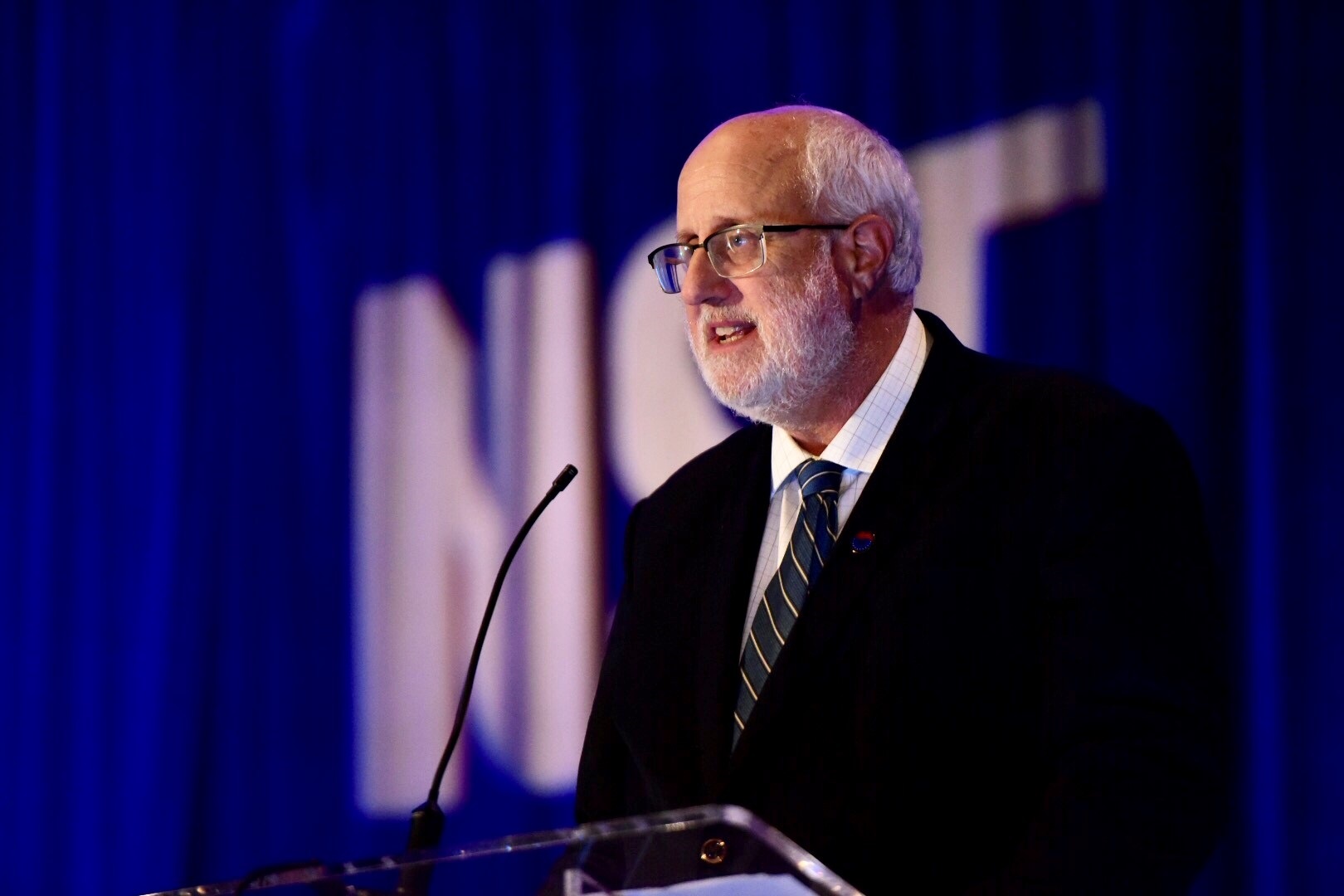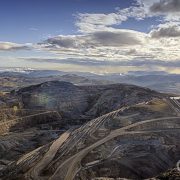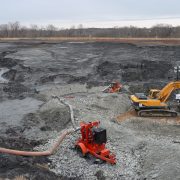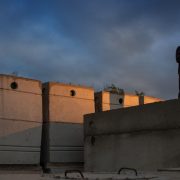The Rapid Rise of Legionella: Q&A with Patrick Breysse of the CDC
For public health “you have to confront Legionnaires’ disease,” Breysse said.

Patrick Breysse, director of the National Center for Environmental Health/Agency for Toxic Substances and Disease Registry, speaks at Legionella Conference 2019, on September 11, 2019. Photo courtesy of NSF International
By Brett Walton, Circle of Blue
Legionnaires’ disease is the deadliest waterborne illness in the United States, killing about one in 11 people it infects. Its symptoms similar to those of pneumonia, the disease is contracted by inhaling water droplets contaminated with Legionella bacteria. The need for a national response is becoming more urgent. The number of reported cases has increased five-fold since the year 2000. Scientists attribute the increase to a confluence of factors: aging water infrastructure, an aging population, better diagnostic tests, complex building plumbing, and water and energy conservation measures that result in warm, stagnant water within buildings. Those are the conditions in which the bacteria like to grow.
Circle of Blue reporter Brett Walton attended Legionella Conference 2019 where he discussed the battle to control the disease with Patrick Breysse, the director of the CDC’s National Center for Environmental Health/Agency for Toxic Substances and Disease Registry. This conversation has been edited for length and clarity.
We’re speaking here today at the Legionella Conference, the second year of this conference. To start with, why is Legionella an important topic for the CDC to look at?
It’s a big source of morbidity associated with water quality systems, in particular. So if you look at water-related disease outbreaks, the majority of water-related disease outbreaks are Legionella or Legionnaires’ disease associated with Legionella exposure. So if you want to worry about health, safety of drinking water systems, and the associated disease outbreaks, you have to confront Legionnaires’ disease and Legionella.
The first outbreak in which Legionella was determined to be the cause was 40-plus years ago. Why does Legionella seem to be getting more attention now, when it’s been an issue for decades?
I think it’s getting more attention now, in part, because the number of cases is increasing over time. As I said in my talk, in the last few decades there’s been a six-fold increase in the number of cases, and we suspect that’s an underreport because we’re probably not diagnosing it well. So the burden is probably even bigger than that, and the rate of change is probably bigger than that, as well.
So we have a disease that is an important public health problem. It results in significant morbidity and mortality associated with drinking water systems. We have an aging public water system in this country, and we have a disease that is increasing over time. So all that represents a nexus for why we should be concerned about it.
Is the number of cases increasing a matter of us looking for it or paying more attention to it?
I don’t think that’s the case. But I’m not entirely sure we know why the cases are increasing. We know they are. There are a lot of challenges with maintaining adequate water systems across the country, in terms of public water supply as well as getting more and more complex water systems in buildings. It all adds to the challenge of addressing the problem.
Buildings are the focus of attention here because it’s a built environment for opportunistic pathogens. There have been a lot of standards and codes that have come out in the last couple of years to try and address the building side of this problem. And you said in your talk today that a water management plan in buildings can prevent a lot of these outbreaks. So can we, with the new codes and standards that are being put out there, quantify the effect of those yet?
I don’t think we can quantify the effect yet. We look forward to doing that in the future, however.
How will you go about doing that?
If everything works out well, we should see a decrease in the number of outbreaks over time. We look forward to seeing that happen.
Outbreaks are not the entire picture. Most cases are individual cases. How does that fit into the picture?
It’s entirely possible that these sporadic cases are also associated with poorly managed building water systems. So you might also see a decrease in sporadic cases as well.
In public health for water, often it seems to be that ignorance is bliss, for lack of a better term. If you don’t test, you don’t know. If you don’t know, then you don’t have to do anything. So we see that for lead. For ever and ever, people didn’t do anything and now they start testing and find lead everywhere. Same thing for perfluorinated chemicals: you start testing, and you find more. Will that be the case with Legionella? As you put more attention on this, and more people become aware, and there’s more testing, are we going to find Legionella in more places than we thought?
I don’t know the answer to that question. We know that Legionella is out there, and Legionella is present in the environment. What we don’t know is how the mere presence of that translates into a disease risk. So if we focus on building management systems and focus on making sure water quality is maintained as best we can, we would expect to see an improvement in the reduction in the transmission of microorganisms to people, whatever the source may be.
The National Academies had a report out recently, and CDC was one of the funders, that tried to bring together all the science and a best effort of what we know about Legionella, what the questions are. One of the recommendations they had was a threshold at which action should be taken, at which the number of Legionella bacteria becomes a risk. Is that something the CDC is looking at, and in the report, in general, are there other recommendations you think are helpful?
We congratulate the National Academies on the report. We think, taken in total, is an excellent constellation of information that we’re going to use very carefully going forward. However, we don’t necessarily agree with everything in the report. The benefit of the National Academy is that you get an independent assessment. But the detriment is that you don’t always have to agree with that independent assessment.
In the case with the threshold, we don’t think there is enough evidence to establish a threshold at this time. We think the best approach is to maintain water systems as best as possible. And in healthcare environments, if we detect Legionella at all we think something should be done to look at the building management system and address it. I’m not sure if there’s a threshold, and certainly if you’re in a hospital environment where you have immune-compromised people and other people at risk, it’s not at all clear that even detectable levels shouldn’t be addressed.
You mentioned that CDC is working with local and state health departments to provide tools and expertise to be able to respond and assess Legionella. Can you explain a bit more about what that work is: what state and local health departments need to know?
As I said in my talk, we have cooperative agreements with states to build capacity to address Legionnaires’ and Legionella in the environment. We have to build capacity at the local level to deal with these problems. That’s got to be a key piece of the solution going forward. We’re also distilling information in our tool kit so that it’s accessible for health departments and other professionals. And we have crucial online training as well to help professionals develop building management plans and understand the dimensions of the problem. This capacity building is key to ultimately getting to the solution.
Brett writes about agriculture, energy, infrastructure, and the politics and economics of water in the United States. He also writes the Federal Water Tap, Circle of Blue’s weekly digest of U.S. government water news. He is the winner of two Society of Environmental Journalists reporting awards, one of the top honors in American environmental journalism: first place for explanatory reporting for a series on septic system pollution in the United States(2016) and third place for beat reporting in a small market (2014). He received the Sierra Club’s Distinguished Service Award in 2018. Brett lives in Seattle, where he hikes the mountains and bakes pies. Contact Brett Walton













Leave a Reply
Want to join the discussion?Feel free to contribute!